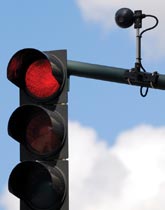Steve Smith often drives home this way, stopping at Whole Foods. Yet today, the familiar route feels faster. Beside him, his iPhone logs his times between intersections. Smith, director of the Intelligent Coordination and Logistics Laboratory in CMU’s Robotics Institute, not only feels a difference, he’s measuring it—and he helped create it.

Over three months, his team crisscrossed streets in Pittsburgh’s East Liberty neighborhood, testing their pilot system, Surtrac (Scalable Urban Traffic Control), which uses a hybrid stoplight bundled with video cameras and a Surtrac processor.
Here’s how it works: When the video cameras see approaching traffic, the Surtrac processor computes a plan for how all of the vehicles are going to move through, Smith says. The stoplight then follows Surtrac’s plan, streamlining traffic flow, and Surtrac shares the data with other stoplights to minimize cumulative delay for a larger area.

Smith began with a software model, simulating how a few strategic Surtrac stoplights would improve Pittsburgh’s downtown traffic. After successfully mastering this exercise, he looked for a real-world testing ground that became East Liberty.
The neighborhood was selected after Smith was stopped at a red light down the street from Whole Foods: “I looked up and realized the lights had cameras.” This pre-existing equipment made East Liberty a “low-cost site.” Last year, the team drove the test area’s 12 busiest routes, setting a benchmark. Three months later, they collected data again, with Surtrac scheduling the stoplights.
In results announced last September, the pilot reduced travel time by 25% and cut vehicle emissions by 21%. Smith plans to expand the pilot in Pittsburgh this year and, eventually, to other cities.
—Aaron Jentzen (DC’12)
Related Links:
18 Brilliant Ways To End Gridlock And Save Billions
Business Insider



